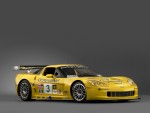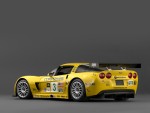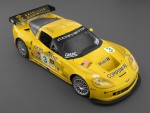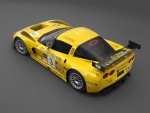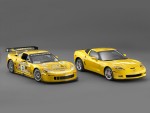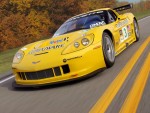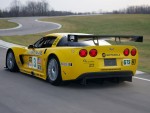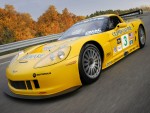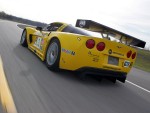2005 Chevrolet Corvette C6-R
2005 Chevrolet Corvette C6-R Pictures & Specifications
Home »
Chevrolet
Pictures & Wallpapers
Technical Specifications
Make: Chevrolet
Model: Corvette C6-R Race Car
Engine: 7.0 litre V8
Aspiration: Natural
Maximum Power: 580 hp (433 kW) @ 5400 rpm
Maximum Torque: 610 lb-ft (826 Nm) @ 4400 rpm
Transmission: Six-speed manual
Drivetrain: Rear-wheel drive
Chevrolet Corvette C6-R Race Car Launches For 2005
GM Media Release
10 January 2005
The brand-new Corvette C6-R race car will debut at the 12 Hours of Sebring in March 2005 after a full year of rigorous testing and development. The two-car, factory-backed Chevrolet sports car program will compete in the production-based GT1 class (formerly GTS) of American Le Mans Series as well as the legendary 24 Hours of Le Mans in France, a race where the Corvette has won its class for three out of the past four years. The new race car is the most technically advanced sports car ever developed by General Motors, culling years of experience from the dominant Corvette C5-R as well as the advancements brought forth from the next-generation Corvette C6 and Z06 production models.
“The Corvette C6-R is the best sports car we’ve ever built and it has been our privilege to develop it alongside the new Corvette Z06,” said Harry Turner, GM’s group manager for road racing. “History will remember the C5-R as one of the best sports racing cars of all-time and we’ve set the bar high for the C6-R. With the new C6 chassis and body structure as our starting point, we’re already ahead. We left no stone unturned in the development of this new car and we are looking forward to racing it in front of the world in 2005.”
Like the C5-R before it, the Corvette C6-R starts from production roots: the same hydroformed frame rails that roll down the assembly line at the Corvette plant in Bowling Green, Kentucky are sourced for the structure of the race car. With the new C6 production model measuring shorter in overall length (but with a longer wheelbase), race car engineers faced a new set of numbers in which to achieve their goals to make the car faster on the 180-mph Mulsanne Straight at Le Mans and other high-speed circuits.
“At first glance, the shortened front and rear overhangs on the C6 would seem to present a challenge in developing a race car with maximum aerodynamic downforce,” said Steve Wesoloski , program engineering manager for Corvette Racing. “However, the low drag features on the C6, such as the sleek body and flush headlamps, lend themselves to an easy task of converting the production design into a low-drag race car.”
Adding a rear wing and a front splitter enabled the team to develop a package that achieves a lift-to-drag ratio better than that of the C5-R. Through a combination of Computational Fluid Dynamic studies and on-track testing, the end result will be an aerodynamically balanced package, tunable to the low drag demands of Le Mans or the high downforce requirements of Mosport.
The phrase “technology transfer” has never been more appropriate than when used to describe the matched set of Corvette C6-R and Corvette Z06. Lessons learned on the track have benefited the Z06, just as GM’s vast resources have enriched the C6-R race car. Both cars are powered by 7-litre small-block V8 engines with dry-sump lubrication systems, CNC-ported cylinder heads, titanium valves and connecting rods, forged steel crankshafts, and plate-honed cylinder bores. While the components and specifications of the street and competition engines are tailored to their specific environments, the thought process behind them is identical.
The same six drivers that piloted the C5-Rs to an historical undefeated season in 2004 will return to the track in 2005: Ron Fellows, Johnny O’Connell and Max Papis will drive the #3 Corvette C6-R and Oliver Gavin , Olivier Beretta and Jan Magnussen will drive the #4 Corvette C6-R.
